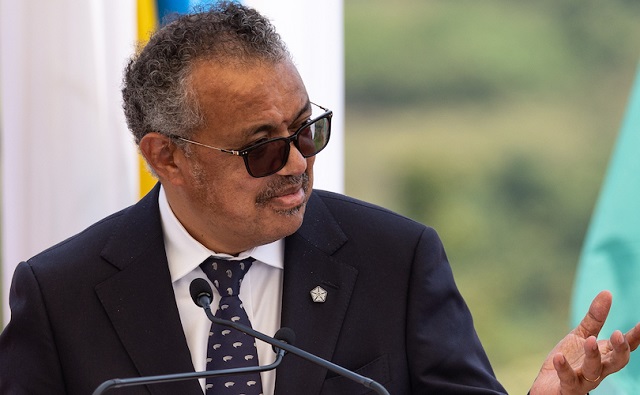Great Reset
WHO claims bird flu strain infected human for first time, has ‘potential for high public health impact’

Director-General of the World Health Organization, Dr Tedros Adhanom Ghebreyesus, speaks at a groundbreaking ceremony of BioNTech’s first mRNA vaccine manufacturing facility in Africa.
From LifeSiteNews
The WHO said a new strain of bird flu jumped to humans for the first time and killed a man in Mexico, but Mexican authorities say the man died due to long-term diseases, and experts like Dr. Peter McCullough are pointing to gain-of-function research.
The World Health Organization (WHO) said this week that a new strain of bird flu detected in humans for the first time has a “potential for high public health impact.”
According to officials, a 59-year-old man in Mexico with “multiple underlying conditions,” who died after battling a weeklong illness, tested positive for H5N2, a strain of bird flu that has never been seen in humans. That strain is not the same as the H5N1 bird flu that was recently reported in U.S. dairy farms.
READ: The US government’s ‘psychopathic’ record on bioweapons should give us pause about ‘bird flu’ claims
The man’s relatives said that he was bedridden for other reasons for three weeks before becoming infected, after which he suffered “fever, shortness of breath, diarrhea and nausea,” according to the Daily Mail.
While the WHO described the illness as a “confirmed fatal case of human infection with avian influenza A(H5N2) virus,” Mexico’s health ministry said the death was due to underlying conditions that led to septic shock, Reuters reported.
“The diseases were long-term and caused conditions that led to the failure of several organs,” the department said.
The WHO said it believes the virus poses a “low” risk to the general population, in part because in the past, “A(H5) viruses… have not acquired the ability to sustain transmission between humans.”
However, the global health body claimed that human infections with an influenza A virus or cases of human exposure to such a viral outbreak in animals make “necessary” “enhanced surveillance in potentially exposed human populations.”
READ: Rep. Chris Smith warns WHO pandemic treaty is the greatest threat to freedom in human history
The WHO also said that in cases of “confirmed or suspected human infection caused by a novel influenza A virus with pandemic potential,” including the bird flu, the case’s “history of exposure to animals and/or travel” should be logged, “along with contact tracing.”
It is unclear how the Mexican man would have contracted the bird flu, in part because he was reported to have had no connection to farms or poultry.
Dr. Peter McCullough, one of the most highly published cardiologists in history, has pointed to gain-of-function research as a likely explanation for a “jump” of bird flu from animals to humans, alluding to the fact that it has long historically only been detected in animals. He called for a shutdown of U.S. gain-of-function labs and warned that animal culling and bird flu vaccines would only create “more resistant strains.”
Gain-of-Function Bird Flu Proximal Origins of Current Strain from USDA Southeast Poultry Research Laboratory and Spreading in Migratory Wild Birds
Lycett et al have published that bird flu has probably been around for >100 years. Why is it suddenly a problem now? Evaluate the… https://t.co/IpmChzksbm pic.twitter.com/sz98U6vyd4
— Peter A. McCullough, MD, MPH® (@P_McCulloughMD) June 6, 2024
Already, over four million chickens in Iowa are on the chopping block because of reported detection of bird flu among their flock, and it was recently announced that the U.S. government is close to an “agreement to fund a late-stage trial of Moderna’s mRNA bird flu vaccine.”
READ: Yes, COVID came from a lab. When will the mainstream media quit gaslighting us?
Dr. Joseph Mercola pointed out in 2022 that Bill Gates and Dr. Anthony Fauci have spent years funding research to “develop a bird flu pathogen capable of infecting humans,” as Alexis Baden-Mayer showed in an article published last year. Some of this gain-of-function research has taken place in U.S. Department of Defense-funded biolabs in Ukraine.
Mercola noted that Christian Westbrook (the “Ice Age Farmer”) detailed in one video Gates’ funding of Dr. Yoshihiro Kawaoka in Wisconsin to identify mutations in various bird flu strains that could have pandemic potential. Fauci has also funded Kawaoka’s work since 1990.
“In one experiment, Kawaoka mixed bird flu virus with the Spanish flu virus, resulting in a highly lethal respiratory virus with human transmission capability. Kawaoka has also played around with mixtures of H5N1 and the 2009 H1N1 (swine flu) virus, creating an airborne hybrid capable of completely evading the human immune system, effectively rendering humans defenseless against it,” explained Dr. Mercola.
READ: Doctor warns WHO pandemic treaty includes ‘gain of function’ data sharing
Remarkably, the scientist Dr. Michael Gregor, a vegan who once once testified on behalf of Oprah Winfrey in her “meat defamation” trial, has repeatedly claimed that chicken farms will trigger an apocalyptic virus that will threaten half of humankind. In 2006, he published a book called Bird Flu: A Virus of Our Own Hatching, in which he says that “leading public health authorities now predict as inevitable a pandemic of influenza, triggered by bird flu and expected to lead to millions of deaths around the globe.”
Accordingly, Westbrook “suspects a weaponized bird flu may be released to usher in The Great Reset and Fourth Industrial Revolution, which include the elimination of traditional farming and meat consumption in favor of patented, lab-created ‘foods,’” Dr. Mercola noted. In Westbrook’s words, this would be a “a controlled demolition of the protein supply.”
Censorship Industrial Complex
US Under Secretary of State Slams UK and EU Over Online Speech Regulation, Announces Release of Files on Past Censorship Efforts

Sarah Rogers’ comments draw a new line in the sand between America’s First Amendment and Europe’s tightening grip on online speech.
|
|
Digital ID
Canadian government launches trial version of digital ID for certain licenses, permits

From LifeSiteNews
The Employment and Social Development Canada (ESDC) department has officially confirmed it is developing a digital ID for certain licenses and permits.
The Employment and Social Development Canada (ESDC) department has officially confirmed it is developing a digital ID for certain licenses and permits, called “GC Issue and Verify,” which has already been listed on the Google Play store, as a trial-only app for certain users.
The digital ID claims the government can replace and be full “digital versions” of the “physical credentials they already provide today, like work permits and boating licenses.”
“Instead of only having physical credentials in their wallets, people will also be able to securely store their digital credentials on their mobile devices,” says the government.
According to ESDC officials, the digital IDs can be shared online or in-person “when needed, making it easy for departments, organizations, and businesses to validate their information.”
The government argued that since many Canadians already use “digital credentials without realizing it,” such as a digital ticket “stored on our mobile device instead of using a printed ticket,” this would be the same for IDs such as licenses.
ESDC said that “digital options” will be voluntary and that people can still use “traditional physical methods of verification,” instead.
READ: Canada releases new digital ID app for personal documents despite privacy concerns
The reality is that digital IDs and similar systems have long been pushed by globalist groups like the World Economic Forum, an organization with which Canadian Prime Minister Mark Carney has extensive ties, under the guise of ease of access and security.
Also, Canadians do not want digital IDs, as noted by Canada’s Privy Council research from 2023, which said there is strong public resistance to the use of digital IDs to access government services.
GC Issue and Verify is one of two digital ID projects on the go. As reported by LifeSiteNews, the Liberal government under Carney recently quietly released a new type of digital ID app on Google’s Play Store called GC Wallet.
Both GC Wallet and GC Issue and Verify are now being tested with federal partners, those being Transport Canada and Immigration, Refugees and Citizenship Canada.
During COVID, the Canadian federal government released a digital-type app called ArriveCAN app for travel that was a form of digital ID. The app was riddled with technical glitches along with privacy concerns from users.
As reported by LifeSiteNews, the Canadian government hired outside consultants tasked with looking into whether or not officials should proceed with creating a digital ID system for all citizens and residents.
Opp0sition MP Leslyn Lewis, recently warned Canadians to be “on guard” against a push by the ruling Liberal Party to bring forth digital IDs, saying they should be voluntary.
-

 Business2 days ago
Business2 days agoLargest fraud in US history? Independent Journalist visits numerous daycare centres with no children, revealing massive scam
-

 Business2 days ago
Business2 days ago“Magnitude cannot be overstated”: Minnesota aid scam may reach $9 billion
-

 Business21 hours ago
Business21 hours agoWhat Do Loyalty Rewards Programs Cost Us?
-

 Business9 hours ago
Business9 hours agoLand use will be British Columbia’s biggest issue in 2026
-

 Censorship Industrial Complex2 days ago
Censorship Industrial Complex2 days agoUS Under Secretary of State Slams UK and EU Over Online Speech Regulation, Announces Release of Files on Past Censorship Efforts
-

 Haultain Research21 hours ago
Haultain Research21 hours agoSweden Fixed What Canada Won’t Even Name
-

 Business6 hours ago
Business6 hours agoMainstream media missing in action as YouTuber blows lid off massive taxpayer fraud
-

 Energy9 hours ago
Energy9 hours agoWhy Japan wants Western Canadian LNG



